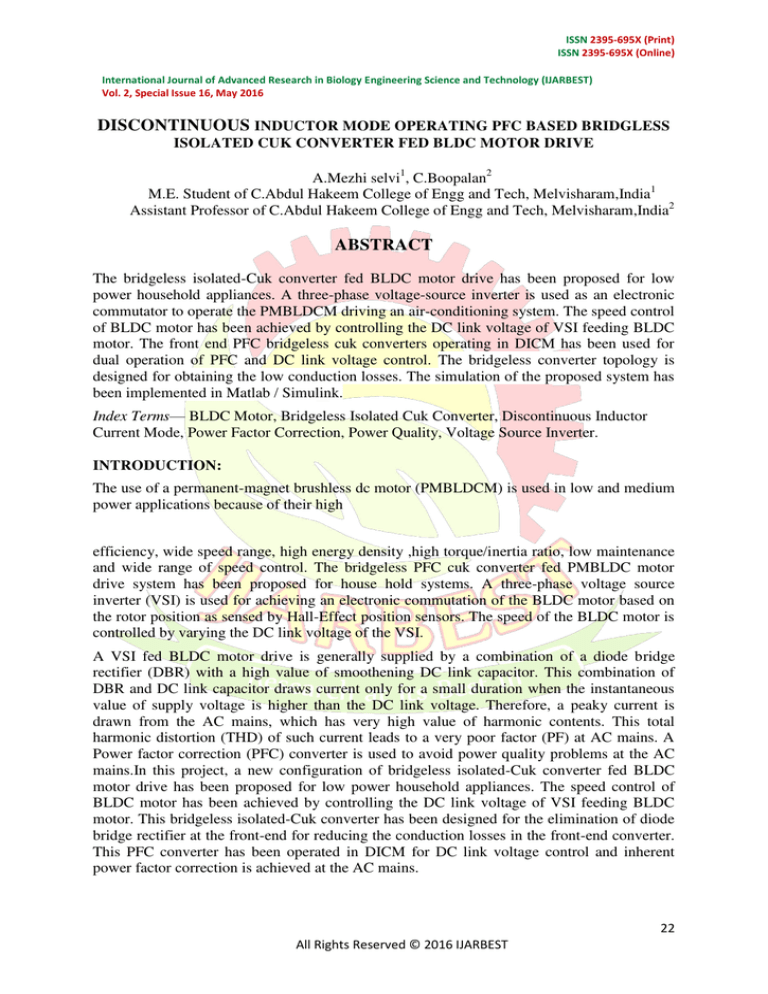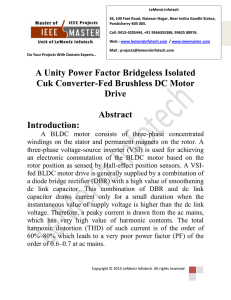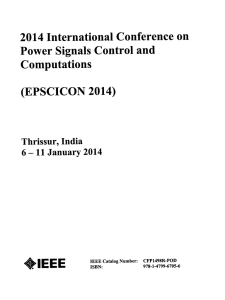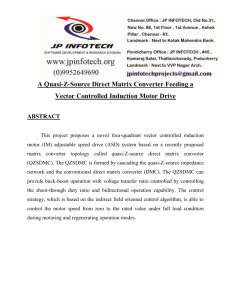
ISSN 2395-695X (Print)
ISSN 2395-695X (Online)
International Journal of Advanced Research in Biology Engineering Science and Technology (IJARBEST)
Vol. 2, Special Issue 16, May 2016
DISCONTINUOUS INDUCTOR MODE OPERATING PFC BASED BRIDGLESS
ISOLATED CUK CONVERTER FED BLDC MOTOR DRIVE
A.Mezhi selvi1, C.Boopalan2
M.E. Student of C.Abdul Hakeem College of Engg and Tech, Melvisharam,India1
Assistant Professor of C.Abdul Hakeem College of Engg and Tech, Melvisharam,India2
ABSTRACT
The bridgeless isolated-Cuk converter fed BLDC motor drive has been proposed for low
power household appliances. A three-phase voltage-source inverter is used as an electronic
commutator to operate the PMBLDCM driving an air-conditioning system. The speed control
of BLDC motor has been achieved by controlling the DC link voltage of VSI feeding BLDC
motor. The front end PFC bridgeless cuk converters operating in DICM has been used for
dual operation of PFC and DC link voltage control. The bridgeless converter topology is
designed for obtaining the low conduction losses. The simulation of the proposed system has
been implemented in Matlab / Simulink.
Index Terms— BLDC Motor, Bridgeless Isolated Cuk Converter, Discontinuous Inductor
Current Mode, Power Factor Correction, Power Quality, Voltage Source Inverter.
INTRODUCTION:
The use of a permanent-magnet brushless dc motor (PMBLDCM) is used in low and medium
power applications because of their high
efficiency, wide speed range, high energy density ,high torque/inertia ratio, low maintenance
and wide range of speed control. The bridgeless PFC cuk converter fed PMBLDC motor
drive system has been proposed for house hold systems. A three-phase voltage source
inverter (VSI) is used for achieving an electronic commutation of the BLDC motor based on
the rotor position as sensed by Hall-Effect position sensors. The speed of the BLDC motor is
controlled by varying the DC link voltage of the VSI.
A VSI fed BLDC motor drive is generally supplied by a combination of a diode bridge
rectifier (DBR) with a high value of smoothening DC link capacitor. This combination of
DBR and DC link capacitor draws current only for a small duration when the instantaneous
value of supply voltage is higher than the DC link voltage. Therefore, a peaky current is
drawn from the AC mains, which has very high value of harmonic contents. This total
harmonic distortion (THD) of such current leads to a very poor factor (PF) at AC mains. A
Power factor correction (PFC) converter is used to avoid power quality problems at the AC
mains.In this project, a new configuration of bridgeless isolated-Cuk converter fed BLDC
motor drive has been proposed for low power household appliances. The speed control of
BLDC motor has been achieved by controlling the DC link voltage of VSI feeding BLDC
motor. This bridgeless isolated-Cuk converter has been designed for the elimination of diode
bridge rectifier at the front-end for reducing the conduction losses in the front-end converter.
This PFC converter has been operated in DICM for DC link voltage control and inherent
power factor correction is achieved at the AC mains.
22
All Rights Reserved © 2016 IJARBEST
ISSN 2395-695X (Print)
ISSN 2395-695X (Online)
International Journal of Advanced Research in Biology Engineering Science and Technology (IJARBEST)
Vol. 2, Special Issue 16, May 2016
The BLDC motor has advantages such as high efficiency, high torque/inertia ratio, speed
control and low noise and electro-magnetic interference (EMI) make brushless DC (BLDC)
motor an ideal choice in many applications [1]. The BLDC motor finds applications in many
household appliances, industrial tools, medical equipments, precise motion control and
automation and transportation [1-5]. The BLDC motor is made of three phase concentrated
windings on the stator and permanent magnets on the rotor [1]. A three-phase voltage source
inverter (VSI) is used to achieve an electronic commutation of the BLDC motor [6]. A VSI
fed BLDC motor drive is provided by a combination of a diode bridge rectifier (DBR) and a
high value of smoothening DC link capacitor [7]. This combination of DBR and DC link
capacitor draws current only for a small duration when the instantaneous value of supply
voltage is higher than the DC link voltage [8]. Peaky current is drawn from the AC mains,
which has very high value of harmonic contents [8]. The total harmonic distortion (THD) of
current is in the order of 60-80 % which leads to a very poor factor (PF) [9]. The current
sensors are required for achieving the pulse width modulation (PWM) based current control
of BLDC motor for speed control [6, 7]. Moreover, such BLDC motor drives suffer from
high losses in VSI due to high switching frequency. These losses are reduced by operating the
VSI in low frequency switching by electronically commutating the BLDC motor. Moreover,
the speed of the BLDC motor is controlled by varying the DC link voltage of the VSI [7].
Power factor correction (PFC) converters avoid power quality problems at the AC
mains and to meet the prescribed guidelines of IEC 61000-3-2 [10, 11]. The PFC converter
plays major role in deciding the cost of overall system. The number of sensors for a PFC
converter is primarily decided by mode of operation of the PFC converter. Continuous
inductor current mode (CICM) and discontinuous inductor current mode (DICM) are two
modes of operation of the PFC converter. In CICM, or
continuous conduction mode (CCM), the current in inductor remains continuous in a
switching period, whereas the current becomes discontinuous in a switching period for a PFC
converter operating in DICM. The PFC converter operating in CICM uses a current multiplier
approach for voltage control and power factor correction. It induces lower current stress on
the PFC converter switch and needs three sensors (2-V, 1-C) for its operation. A single
voltage sensor is used for a PFC converter operating in DICM using voltage follower
approach, but at the cost of high current stress on the PFC converter switches [12]. This mode
of operation is suited for low power applications.
II. PROPOSED PFC BRIDGELESS ISOLATED-CUK CONVERTER
FED BLDC MOTOR DRIVE
Fig. 1 shows the proposed PFC bridgeless isolated-Cuk converter fed BLDC motor
drive. A single-phase supply is followed by a LC-filter to feed a bridgeless isolated- Cuk
converter. The Converter maintains the required DC link voltage of the VSI and provides
power factor correction at AC mains. The proposed PFC converter is operated in DICM to
behave as an inherent power factor corrector. The DC link voltage of the VSI is controlled for
varying the speed of the BLDC motor. The BLDC motor is operated in a low frequency
switching to achieve an electronic commutation of BLDC motor. The single voltage sensor
controls the DC link voltage to achieve speed control of BLDC motor. The proposed drive is
designed and its performance is validated on a developed prototype for improved power
quality at AC mains for a speed control with different supply voltages.
23
All Rights Reserved © 2016 IJARBEST
ISSN 2395-695X (Print)
ISSN 2395-695X (Online)
International Journal of Advanced Research in Biology Engineering Science and Technology (IJARBEST)
Vol. 2, Special Issue 16, May 2016
III. OPERATION OF PFC BASED BRIDGELESS ISOLATED-CUK
CONVERTER
The proposed PFC converter operation is classified into two different sections such as
a line cycle and a switching cycle. Fig. 2 shows six different modes of operation.
A. Line Cycle operation mode
The proposed bridgeless isolated-Cuk converter is designed with two switches Sw1
and Sw2 that conducts for positive and negative half cycles of supply voltage respectively. In
positive half cycle of supply voltage, switch Sw1, inductors Li1 and Lo1, intermediate
capacitors C11 and C21 and diodes D1 and Dp are in state of conduction and vice-versa for
negative half cycle of supply voltage as shown in Figs. 2 (a-f).
During the DICM operation, the current of output inductors (Lo1 and Lo2) becomes
discontinuous in a switching period. Therefore, the current flowing in input and magnetizing
inductance of HFT (Li1, Li2, Lm1 and Lm2) and voltage across the intermediate capacitor
(C11, C12, C21 and C22) remain continuous in a complete switching period.
B. Switching Cycle operation mode
Figs. 2 (a-c) shows three modes of operation Cuk converter in a switching period for
positive half cycle of supply voltage.
P-I mode: In PI mode, the switch (Sw1) is turned-on, and the input inductor (Li1), output
inductor (Lo1) and magnetizing inductance of high frequency transformer (HFT) (Lm1) are
charged as shown in Fig. 2 (a). The input side intermediate capacitor (C11) supply energy to
the HFT and output side intermediate capacitor (C21) supply the energy to the DC link
capacitor.
P-II mode: In this mode switch (Sw1) is turned-off, input inductor (Li1), output
inductor (Lo1) and magnetizing inductance of HFT (Lm1) starts discharging. The
intermediate capacitors (C11 and C21) charge and the DC link capacitor (Cd) also discharges
in this interval.
24
All Rights Reserved © 2016 IJARBEST
ISSN 2395-695X (Print)
ISSN 2395-695X (Online)
International Journal of Advanced Research in Biology Engineering Science and Technology (IJARBEST)
Vol. 2, Special Issue 16, May 2016
P-III mode: In this mode, the input inductor (Li1) and magnetizing inductance of HFT
(Lm1) continue to discharge and the output side inductor (Lo1) is completely discharged. The
output side intermediate capacitor (C21) continues charging and the DC link capacitor (Cd)
supply the energy to BLDCM. The operation for the negative half cycle of the supply voltage
is realized in the similar way.
The intermediate capacitors (C11, C12, C21 and C22) are completely discharged and are
charged during the operation of the PFC converter initially. The voltage across the input side
intermediate capacitors (C11 and C12) depend upon the instantaneous input voltage; hence,
the initial charging voltage of C11 and C12 is zero. However, the output side intermediate
capacitors (C21 and C22) are not completely discharged in a switching period or a half line
cycle of supply voltage due to the voltage maintained at the DC link capacitor (Cd).
Moreover, during the operation of PFC converter in positive half cycle; the energy storage
components on the primary side of the HFT (i.e. Li2, C12 and Lm2) remain in nonconducting state and are completely discharged. The energy storage components on the
secondary side of HFT (i.e. C22) remain charged at its full voltage due to the unavailability
of discharging path and the presence of DC link capacitor (Cd).
25
All Rights Reserved © 2016 IJARBEST
ISSN 2395-695X (Print)
ISSN 2395-695X (Online)
International Journal of Advanced Research in Biology Engineering Science and Technology (IJARBEST)
Vol. 2, Special Issue 16, May 2016
IV SIMULATION RESULTS
Input Voltage
DC Link Voltage
Inverter Voltage and Current
Phase Voltage
26
All Rights Reserved © 2016 IJARBEST
ISSN 2395-695X (Print)
ISSN 2395-695X (Online)
International Journal of Advanced Research in Biology Engineering Science and Technology (IJARBEST)
Vol. 2, Special Issue 16, May 2016
Phase current
Pulse width Modulation Output
Rotor speed
Stator Current
27
All Rights Reserved © 2016 IJARBEST
ISSN 2395-695X (Print)
ISSN 2395-695X (Online)
International Journal of Advanced Research in Biology Engineering Science and Technology (IJARBEST)
Vol. 2, Special Issue 16, May 2016
Torque
RESULTS AND DISCUSSION
A new configuration of bridgeless Cuk converter fed BLDC motor drive has been
proposed for low power household appliances. The speed control of BLDC motor has been
achieved by controlling the DC link voltage of VSI feeding BLDC motor. This has facilitated
the operation of VSI in low frequency switching mode for reducing the switching losses
associated with it. This bridgeless Cuk converter has been designed for the elimination of
diode bridge rectifier at the front-end for reducing the conduction losses in the front-end
converter. This PFC converter has been operated in DICM for DC link voltage control and
inherent power factor correction is achieved at the AC mains. A prototype of proposed drive
has been implemented using a DSP. Satisfactory test results for proposed bridgeless isolatedCuk-converter fed BLDC motor has been evaluated for its operation over complete speed
range. Moreover, the performance of proposed drive is also evaluated for operation at wide
range of supply voltages. The obtained power quality indices have been found within limits
of power quality standards as IEC61000-3-2.
The proposed work realizes achievement of unity power factor operating the
bridgeless cuk converter in the DICM mode. The future work implements hardware
configuration of the BLDC with Bridgeless cuk converter.
REFERENCE
[1] C. L. Xia, Permanent Magnet Brushless DC Motor Drives and Controls Wiley Press,
Beijing, 2012.
[2] Y. Chen, C. Chiu, Y. Jhang, Z. Tang and R. Liang, “A Driver for the Single-Phase
Brushless DC Fan Motor with Hybrid Winding Structure,” IEEE Trans. Ind. Electron., vol.
60, no. 10, pp. 4369
[3] X. Huang, A. Goodman, C. Gerada, Y. Fang and Q. L Matrix Converter Drive for a
Brushless DC Motor in Aerospace Applications,” IEEE Trans. Ind. Elect.,
Sept. 2012.
28
All Rights Reserved © 2016 IJARBEST
ISSN 2395-695X (Print)
ISSN 2395-695X (Online)
International Journal of Advanced Research in Biology Engineering Science and Technology (IJARBEST)
Vol. 2, Special Issue 16, May 2016
[4] J. Moreno, M. E. Ortuzar and J. W. Dixon, “Energy for a hybrid electric vehicle, using
ultra capacitors and neural networks,” IEEE Trans. Ind. Electron., vol.53, no.2, pp. 614
[5] P. Pillay and R. Krishnan, “Modeling of permanent magnet motor drives,” IEEE Trans.
Ind. Elect.vol.35, no.4, pp.537
[6] H. A. Toliyat and S. Campbell, DSP-based Electromechanical Motion Control, CRC
Press, New York, 2004.
[7] S. Selvakumar, Dr.S.Ravi, “Adaptive Modulation IN Reconfigurable Platform” Journal of
Theoretical and Applied Information Technology. Vol 68, PP 108-114, Oct 2014
[8] N. Mohan, T. M. Undeland and W. P. Robbins, Converters, Applications and Design,
John Wiley and Sons Inc, USA, 2009.
[9] V. Bist and B. Singh, “An Adjustable Speed PFC Bridgeless Buck-Boost Converter Fed
BLDC Motor Drive”, IEEE Tran. Ind. Electron., vol.61, no.6, pp.2665-2677, June 2014.
[10] A. A. Fardoun, E. H. Ismail, A. J. Sabzali, M. A. Al-Saffar, “New Efficient Bridgeless
Cuk Rectifiers for PFC Applications,” IEEE Trans. Power Electron., vol.27, no.7, pp.32923301, July 2012.
[11] B. Singh, S. Singh, A. Chandra and K. Al-Haddad, “Comprehensive Study of SinglePhase AC-DC Power Factor Corrected Converters With High-Frequency Isolation,” IEEE
Trans. Ind. Inform., vol.7, no.4, pp.540-556, Nov. 2011.
[12] V. Bist and B. Singh, “PFC Cuk Converter Fed BLDC Motor Drive”, IEEE Trans.
Power Electron., IEEE Early Access, 2014.
[13] R. Martinez and P. N. Enjeti, “A high performance single phase rectifier with input
power factor correction”, IEEE Trans. Power Electron., vol. 11, no. 2, pp. 311–317, Mar.
1996.,
[14] A. F. de Souza and I. Barbi, “A new ZVS-PWM unity power factor rectifier with
reduced conduction losses” , IEEE Trans. Power Electron., vol. 10, no. 6, pp. 746 –752, Nov.
1996.
[15] A. Barkley, D. Michaud, E. Santi, A. Monti and D. Patterson, “Single Stage Brushless
DC Motor Drive with High Input Power Factor for Single Phase Applications,” 37th IEEE
Power Electr. Spec. Conf., (PESC), pp.1-10, 18-22 June 2006.
[16] S. B. Ozturk, Oh Yang and H. A. Toliyat, “Power Factor Correction of Direct Torque
Controlled Brushless DC Motor Drive,” 42nd IEEE IAS Annual Meeting, pp.297-304, 23-27
Sept. 2007.
29
All Rights Reserved © 2016 IJARBEST
ISSN 2395-695X (Print)
ISSN 2395-695X (Online)
International Journal of Advanced Research in Biology Engineering Science and Technology (IJARBEST)
Vol. 2, Special Issue 16, May 2016
[17] B. K. Lee, B. Fahimi and M. Ehsani, “Overview of reduced parts converter topologies
for AC motor drives,” 32nd Annual IEEE Power Electron. Spec. Conf. (PESC) 2001, vol.4,
pp.2019-2024, 2001.
[18] T. Gopalarathnam and H. A. Toliyat, “A new topology for unipolar brushless DC motor
drive with high power factor,” IEEE Trans. Power Elect., vol.18, no.6, pp. 1397-1404, Nov.
2003.
[19] B. Singh and S. Singh, “Single-phase power factor controller topologies for permanent
magnet brushless DC motor drives,” IET Power Elect., vol.3, no.2, pp.147-175, March 2010.
[20] Y. Jang and M. M. Jovanovic, “Bridgeless High-Power-Factor Buck Converter,” IEEE
Trans. Power Electron., vol.26, no.2, pp.602-611, Feb. 2011.
[21] Y. Jang and M. M. Jovanovic, “A Bridgeless PFC Boost Rectifier With Optimized
Magnetic Utilization,” IEEE Trans. Power Electron., vol.24, no.1, pp.85-93, Jan. 2009.
30
All Rights Reserved © 2016 IJARBEST






